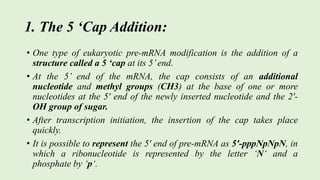Messenger RNA (mRNA) undergoes several types of processing in eukaryotes. mRNA contains 5' and 3' untranslated regions and a protein coding region. In eukaryotes, a 5' cap and poly-A tail are added. Introns are removed from pre-mRNA through splicing in the nucleus. Alternative splicing and cleavage sites allow one gene to code for multiple proteins. RNA editing can further modify the mRNA sequence. These processing steps allow for gene regulation and protein diversity from a single DNA sequence.

































